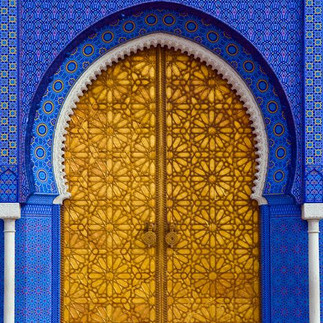The Artistry Behind Moroccan Doors: Unveiling the Allure of Intricate Design
- Jori Sams
- Jun 4, 2024
- 3 min read
Updated: Jun 5, 2024
Discover the mesmerizing world of Moroccan doors with our in-depth exploration of their design, craftsmanship, and allure. From the intricate geometric patterns to the skilled handiwork of master artisans, we unveil the secrets behind these captivating entrances. Join us on a journey through the rich cultural heritage and architectural marvels that make Moroccan doors a symbol of tradition and beauty. See...Saw.

Moroccan doors are more than mere entrances; they are portals to a world of rich cultural heritage and architectural marvels. From the vibrant streets of Marrakech to the hectic riads of Fez, these ornate doorways stand as testaments to Morocco's centuries-old tradition of craftsmanship and design. It serves to make them an integral part of the country's identity and thread.
The Design: At the heart of Moroccan door design lies a fusion of influences from across the centuries. Intricate geometric patterns, arabesque motifs, and ornate carvings adorn the doors, reflecting the diverse cultural heritage of the region. These designs often draw inspiration from Islamic art, Berber symbolism, and Moorish architecture, resulting in a mesmerizing blend of patterns and textures that captivate the eye.
Craftsmanship: Crafting Moroccan doors is a labor of love that requires skill, patience, and a deep understanding of traditional techniques. Master artisans, known as maâlems, meticulously carve, sculpt, and assemble each component by hand, using age-old methods passed down through generations. Wood, often cedar or mahogany, is the primary material used for crafting Moroccan doors due to its durability and natural beauty. Intricate metalwork, such as brass or wrought iron, is also incorporated into the design, adding an extra layer of detail and elegance.
The Process: The process of creating a Moroccan door begins with the selection of high-quality wood, which is then carefully seasoned and treated to ensure durability. Skilled artisans then hand-carve the intricate patterns and motifs onto the wood, using chisels, saws, and other traditional tools. Once the carving is complete, metal elements such as studs, hinges, and decorative hardware are added to enhance the door's visual appeal and functionality. Finally, the door is meticulously finished with stains, varnishes, or paints to bring out the natural beauty of the wood and protect it from the elements.
The Allure: What sets Moroccan doors apart is not just their exquisite craftsmanship, but also the stories they tell and the sense of mystery they evoke. Each door holds a history of the people who have passed through it, the cultures that have influenced it, and the craftsmanship that has brought it to life. Whether adorned with intricate carvings, vibrant colors, or shimmering metalwork, Moroccan doors exude an undeniable charm that beckons travelers to pause, admire, and perhaps even step through into the world beyond.
The Bottom Line: Moroccan doors are more than architectural features; they are embodiments of a rich cultural legacy and a testament to the enduring craftsmanship of the artisans who create them. From their intricate designs to their meticulous craftsmanship, these doors serve as windows into the soul of Morocco, inviting us to explore, appreciate, and marvel at the beauty of this ancient tradition. As we wander through the streets of Morocco, let us not only admire the doors themselves but also the stories, traditions, and craftsmanship that lie behind them.
Every time I visit Morocco and wander its streets, I can't help but pause to admire the ornate and intricate doors that line the way. Each one is a unique masterpiece, adding to my ever-expanding portfolio. Are you also captivated by the charm of Moroccan doors?
Interested in booking a trip to Morocco and having us plan your itinerary? Visit SamSol Travel Solutions. Exquisite Moroccan doors await you...and maybe a camel or two!











Comments